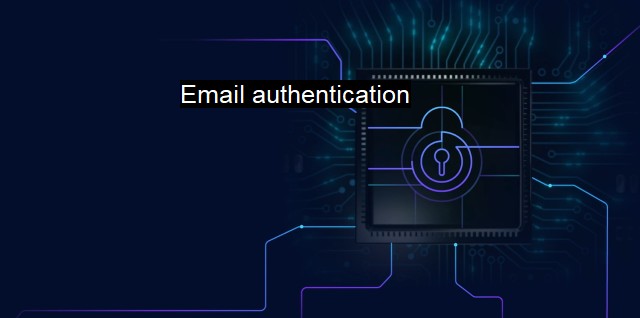What is Email authentication?
Protecting Electronic Communication: The Vital Role of Email Authentication in Preventing Cybercrime and Building Trust Between Senders and Receivers of Emails
Email Authentication is a critical cybersecurity approach that validates the identity of the email sender to protect users from deceptive emails, phishing attacks, and other email-based threats. It helps increase deliverability and reduce the likelihood an email message will be flagged as spam or phishing.Authentication techniques involve complex technical measures to verify an email sender’s identity that goes beyond the simplistic user/password solution. They aim to build a safety net to ensure users that the emails they receive are from genuine and authenticated sources, and not covert cybercriminal operations.
Email authentication comprises of various methods including SPF (Sender Policy Framework), DKIM (Domain Keys Identified Mail) and DMARC (Domain-based Message Authentication, Reporting and Conformance).
SPF is an authentication technique designed to prevent senders from using fake From addresses. The sending domain informs the receiving email server of the IP addresses authorized to send email for it. When the recipient server receives the email, it checks with SPF to ensure the message was sent from an authorized IP address.
DKIM allows the receiving server to verify if the email hasn't been tampered with in transit. It offers a digital signature that indicates that the content of the emails is not altered on the way. When the receiver gets the email, a DKIM evaluation is done, comparing the received email's content with the decrypted hash value. If the two match, the DKIM check is successful, confirming that the email's content hasn't been altered or tampered with.
DMARC blends the controls of SPF and DKIM technologies and ensures that the original domain's email is genuine and has authorization from the domain owner. It provides a feedback mechanism so that the domain owner can evaluate email flows and address any inadequacies. This feedback then aids the entity from whose domain the email emerges to identify problems and remedy them rapidly, thwarting any detrimental effects.
While securing an email system through these authentication protocols isn’t a herculean task, it does call for a solid understanding of email architecture and the potential threats that lie in wait. Also, these steps have to be renewed regularly, because cybercriminals are ever-evolving, coming up with new measures to cross barriers.
Email authentication is not a one-size-fits-all solution. Businesses and corporations with sensitive client data should put in place the most stringent protocols available, even if this could mean fewer users get through due to false positives. On a small-scale individual or family level, though, inconvenience should weigh against potential threat impacts, so a slightly less stringent protocol might be more appropriate.
Perhaps the most essential facet of cybersecurity is anticipation. Cybersecurity's job does not end in only warding off known threats—it is about foreseeing future ones as well. Hence, the development of email authentication must not cease; it must evolve to tackle emerging threats, working much like an antivirus program that is characterized by scheduled scanning, comprehensive protective coverage, regular updates, and an intelligent response mechanism.
Email authentication acts as the first line of defense against increasingly sophisticated email threats. It provides an integral mechanism to help organizations and individuals proactively protect their critical data, secure their networks, and maintain their reputation. As the nature of threats shift, this critical protection mechanism needs to continually adapt and evolve. It empowers users to control who has the right to deliver messages to their domain, hence protecting their email empires against phishing attacks, spoofing, and other forms of abuse.

Email authentication FAQs
What is email authentication?
Email authentication is the process of verifying that the sender of an email is indeed who they claim to be. It is done to prevent fraudulent emails, phishing attacks, and other email-based cyber threats.What are the benefits of email authentication?
Email authentication provides several benefits, such as preventing email spoofing, reducing the risk of data breaches, protecting brand reputation, and enabling better email deliverability. It also helps to establish trust between senders and recipients, thereby improving the overall security of email communications.What are some common email authentication methods?
There are several email authentication methods, including SPF (Sender Policy Framework), DKIM (DomainKeys Identified Mail), and DMARC (Domain-based Message Authentication, Reporting, and Conformance). SPF checks if the sender's IP address is authorized to send emails on behalf of the sender's domain, DKIM verifies the signatures of email messages, and DMARC combines both SPF and DKIM to provide a comprehensive email authentication solution.How can I implement email authentication for my organization?
To implement email authentication, you need to configure your organization's email server to include SPF, DKIM, and DMARC records in outgoing emails. You can also use third-party email authentication tools or services that can help automate the process. It is recommended to work with an experienced cybersecurity professional to ensure proper configuration and maintenance of email authentication protocols.| | A | | | B | | | C | | | D | | | E | | | F | | | G | | | H | | | I | | | J | | | K | | | L | | | M | |
| | N | | | O | | | P | | | Q | | | R | | | S | | | T | | | U | | | V | | | W | | | X | | | Y | | | Z | |
| | 1 | | | 2 | | | 3 | | | 4 | | | 7 | | | 8 | | |||||||